In this guitar lesson, we’re going to take a look at the concept of inverting guitar licks. This is a very simple, but often overlooked, strategy that helps you to get a lot more mileage from all the licks that you learn.
The basic idea of inverting licks is to take a lick and then move the first note to the very end of the lick. This would create a new variation of the lick. You would then repeat this process until you’ve created all the possible lick variations.
Don’t panic if what I just said isn’t totally clear yet. To help you learn this practice strategy we’re going to be taking a guitar lick and going through the entire process now. Here’s the lick that we’ll use for this lesson…
An Example Lick
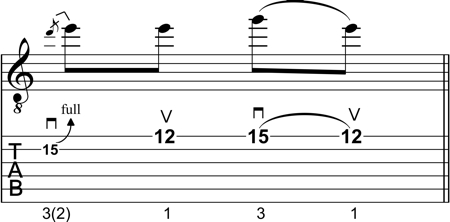
AUDIO: Lick played eight times at 50 bpm
AUDIO: Lick played eight times at 100 bpm
This is a short lick that uses the E Minor Pentatonic scale and is played using eighth-notes. In case you don’t know, this means that you’ll need to play the lick using two evenly-spaced notes per click of your metronome.
OK. Now that we’ve got a lick to use, let’s now look at the process of inverting it.
Step 1: Number Each Note Of The Lick
Although it’s not essential, I find it very helpful to number each note of the lick. This helps to avoid any possible confusion that might happen when you start to create inversions.
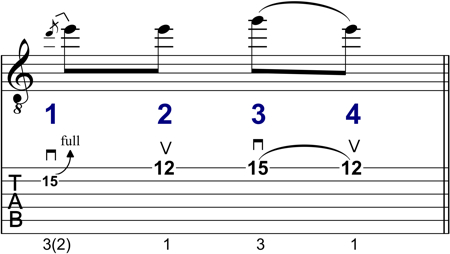
Step 2: Create The First Inversion
To do this, we take the first note of the lick and move it to the very end. What this means is that we’re now playing the notes of the lick in the following order: 2 – 3 – 4 – 1
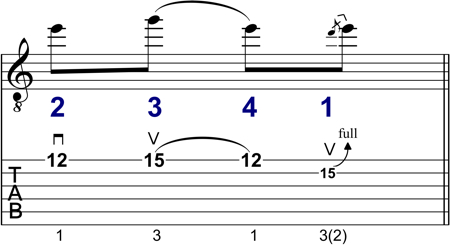
AUDIO: Lick played eight times at 50 bpm
AUDIO: Lick played eight times at 100 bpm
Notice how I have changed how I am articulating the notes of the lick. What I mean by this is that I’ve changed the picking motions to suit the new lick, rather than rigidly using the exact same pick motions that I used for the first lick. For Example: In the first lick I played the bent note using a downstroke. But in this new lick, I am using an upstroke to play the bent note.
Of course, this is my preference and you are free to change it. It’s always a good idea to articulate licks in a way that makes sense to your own preferences and playing style. So if the way I play the lick doesn’t make sense to you, then change it. 🙂
Step 3: Create The Second Inversion
For this step, you take the first note of the first inversion and move it to the very end of the lick. So this means you will play the notes in the following order: 3 – 4 – 1 – 2
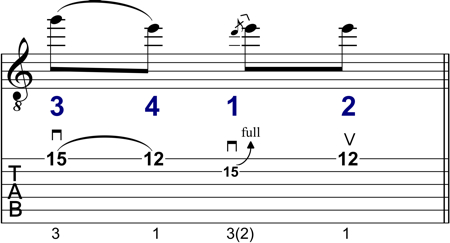
AUDIO: Lick played eight times at 50 bpm
AUDIO: Lick played eight times at 100 bpm
Step 4: Create The Third Inversion
This step involves taking the first note of the second inversion and moving it to the very end of the lick. In other words, you will be playing the notes in this order: 4 – 1 – 2 – 3
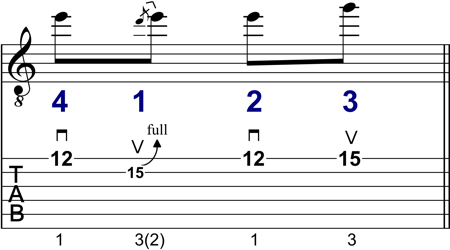
AUDIO: Lick played eight times at 50 bpm
AUDIO: Lick played eight times at 100 bpm
It’s very important to mention here that with all the previous licks there was a pull-off between notes 3 and 4. But the pull-off has been removed in this inversion because notes 3 and 4 are now at opposite ends of the lick. Of course, if I was to play the third inversion repeatedly it would be easy enough to add a pull-off between each repetition of the lick. See the example below to see what I mean…
Example: Third Inversion Played Four Times In A Row

Now that we’ve created the third inversion, we’ve done all the possible inversions for this specific lick. If we were to try to invert the lick once more, we would be back at the very first lick.
A Few Last Words
I hope you enjoyed this lesson. After you master the licks from this lesson, I recommend taking some of your favourite licks and going through the process of inverting them. If you do this on a regular basis, you’ll soon see your soloing vocabulary expand in a very dramatic way!
Are You An Auckland Guitarist That Wants To Significantly Improve Your Electric Guitar Playing?
 If you're an Auckland guitarist wanting to improve your guitar playing, then my Auckland electric guitar lessons might be for you. I can help you to the develop technique, musicianship and mindset that will move you closer to how you truly want to play.
If you're an Auckland guitarist wanting to improve your guitar playing, then my Auckland electric guitar lessons might be for you. I can help you to the develop technique, musicianship and mindset that will move you closer to how you truly want to play.
To find out more about exactly how I can help you improve your playing, then download my latest Auckland guitar lessons info pack below...
